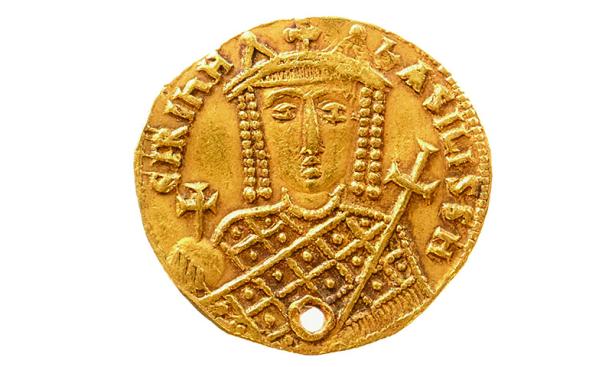
The gold coin is a forceful assertion of power despite being only three-quarters of an inch in diameter and a sixth of an ounce in weight. Struck around A.D. 800 in Constantinople, the Byzantine empress Irene appears on both sides wearing a crown topped with a cross and holding a crucifer in one hand and an orb and cross in the other.
A few years earlier, a similar image of Irene appeared on a gold coin whose other face showed her son and co-regent Constantine VI. But in 797, Irene had her son seized, blinded, and imprisoned in order to become the empire’s sole ruler, said Teresa Shawcross, an associate professor of history and Hellenic studies at Princeton.
The small hole on one edge of the later coin suggests another thread of Byzantine history. Constantine’s father, Leo IV, who married Irene in 768 and died in 780, opposed the veneration of icons in Christian worship, but Irene strongly supported the practice and helped firmly embed it into Orthodox Christianity, Shawcross said. The hole may have been made by a believer who wore the coin on a necklace and kissed the image of Irene as an icon.
With the coin that dates to around 800, Irene “is making a very clear statement: I am the empress,” said Grace Chung ’23, a student of Shawcross who is using the coin in her thesis research. “It’s a very strong image of power, authority, and Christian rule.”
The solidi — gold coins introduced by the Roman emperor Constantine in the 4th century and used for the next 600 years — are two of more than 20,000 Byzantine coins in Princeton’s numismatic collection, the world’s largest trove of Byzantine coins.
These objects aren’t just old money from a bygone empire; they reflect changes in political power, religious practice, and gender relations. Thanks to digital technology, the coins are being made available to researchers around the world. And for both scholars and students, the coins give physical form to the history of late antiquity.
Princeton acquired almost all of its Byzantine coins in three tranches, said Alan Stahl, the curator of the University’s numismatics collection, housed on the C Floor of Firestone Library. From 1932 to 1939, Princeton sponsored an excavation of a store at the ancient and medieval city of Antioch in present-day Turkey and still holds about 24,000 coins from that expedition, about 3,000 of which are from the Byzantine Empire.
In 2016, the library bought 5,280 Byzantine coins from Peter Donald, a retired British government employee whose collection had been “whispered about as legendary for the last 50 years,” Stahl said. One of Donald’s friendly rivals in collecting was Chris B. Theodotou, who suffered a fatal heart attack in 1987 as he and Donald were walking from one London coin dealer to another. Last year, the Theodotou family sold Princeton the collection, which includes 11,256 coins primarily from the Byzantine Empire between A.D. 500 and A.D. 1453. More than 90% of Princeton’s Byzantine coins are bronze.
Stahl said Princeton spent about $500,000 to buy the two collections. The Seeger Center for Hellenic Studies provided half of the funding, and the Friends of Princeton University Library supported the acquisition. In addition to paying for the purchases, Stahl said, “The other aspect we’ve taken seriously is total cost of ownership. It costs money to buy 18,000 coins, but to get them usable, cataloged, and digitized is another pot of money. We’re not just amassing and acquiring, we’re setting up a scholarly apparatus whereby the collection will be shared over the internet with everyone.”
The aim is to have not only all of the Byzantine coins viewable online, as the coins featuring Irene and Constantine VI are, but Princeton’s entire numismatics collection of 115,000 coins, tokens, medals, and bank notes. To date, about 15,000 of those objects have been digitized and are searchable on the library’s website.
Princeton hired Elena Baldi, an expert on Byzantine coins, to oversee its cataloging, some of which is done by undergraduates who also work on other parts of the numismatics collection at a student hourly wage of $17.50.
Chung cataloged coins from the Roman Empire, the Carolingian Empire, and various Greek city-states. “You felt like you were doing research in a very unique way,” she said. “You’re connected to an older story that’s happened since the coin was minted.”
Scholars use coins in many ways, said Jack Tannous *10, an associate professor of history and Hellenic studies at Princeton. “For economic historians, coins are hugely important because they help you get at the nature of the state and how the state wields power,” he said. “To understand how the Byzantine economy functioned, and how the government presented itself and how emperors presented themselves ideologically, coins are essential.”
Like many professors, Tannous brings his classes to the numismatics collection. “To hold an object that a person who lived in the Roman Empire used to pay their taxes or buy bread gives you this sense of connection with the past,” he said.
